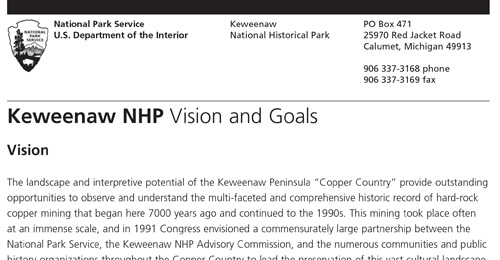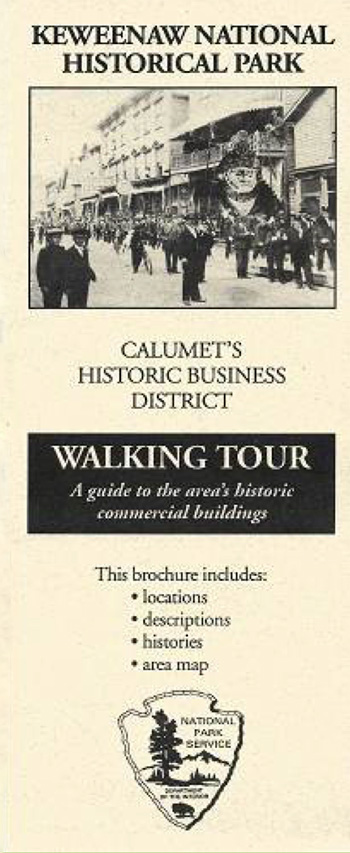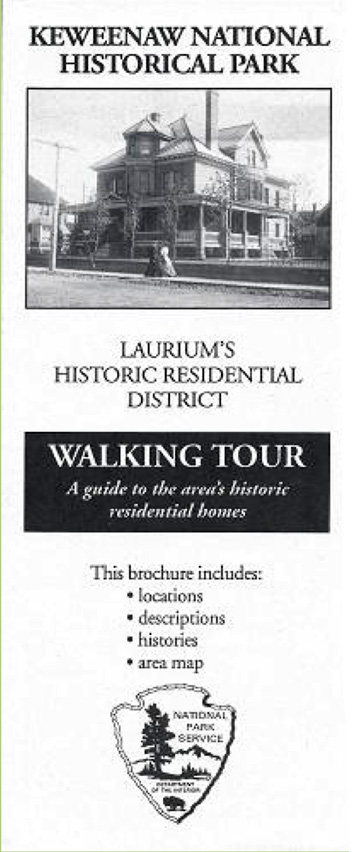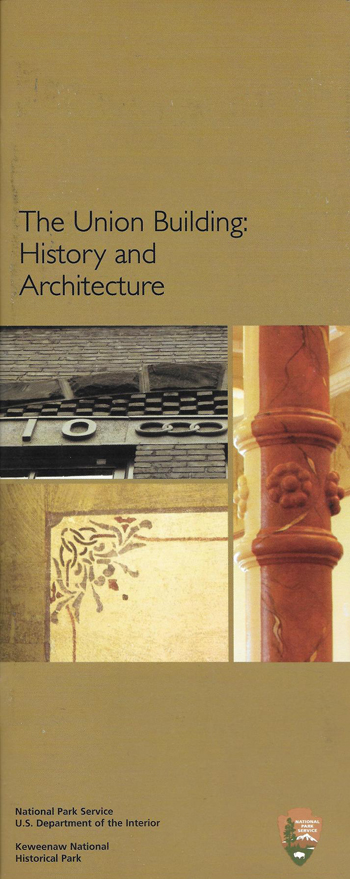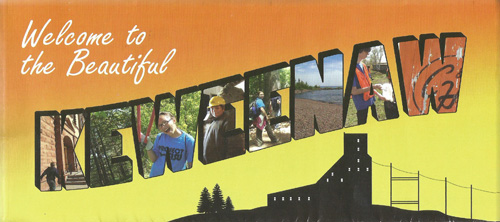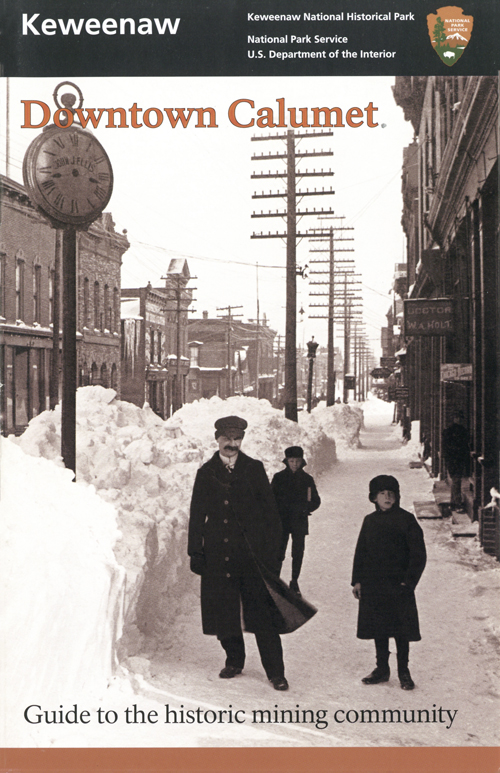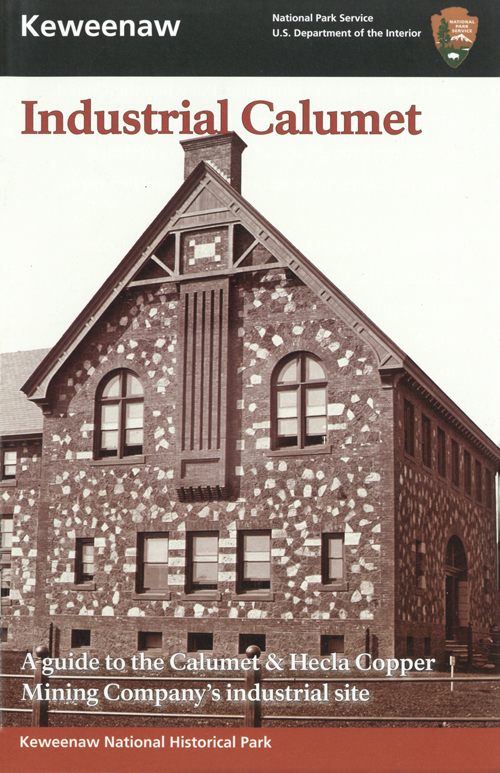|
Keweenaw National Historical Park Michigan |
 |
 NPS photo | |
There can scarcely be a shadow of a doubt [that the Keweenaw Peninsula] will eventually prove of great value to our citizens and to the nation.
—Douglass Houghton, leader of the 1840 expedition that surveyed the mineral resources of Lake Superior's southern shores.
LURE OF THE COPPER COUNTRY
From the top of Michigan's Upper Peninsula, a lonely arc of land points northeast into Lake Superior's expanse. This is a world of trees and water, of a fiery north woods autumn against a backdrop of cool blues. Roads trace the shoreline, trails wind through forests. Around the corner or over a hill, structures emerge—survivors of the Keweenaw's industrial age. Back then the forests were fuel, the waters were commercial routes, and the shaft-rockhouses, stamp mills, and smelters churned out copper day and night. The structures, their setting, and stories of the mining life are preserved and protected at Keweenaw National Historical Park.
The Keweenaw Peninsula had the largest deposit of pure elemental copper in the world. The land was formed by the Portage Lake Volcanics, a series of hundreds of lava flows. The flows hardened into rock layers, some extraordinarily rich in native copper. Over time these layers tilted to form the peninsula's ridged spine, exposing the copper deposits.
Early Native Americans were the groundbreakers—literally. Some 7,000 years ago Lake Superior peoples developed sophisticated mining techniques. The copper was so pure it could be used straight from the ground to make beads, tools, and ornaments. Extensive trade routes carried Keweenaw copper to places like Effigy Mounds National Monument in Iowa, Hopewell Culture National Historical Park in Ohio, and Alberta, Canada.
More recently, copper captivated French, British, and American explorers. When the United States gained title to the Keweenaw in 1842, it opened the door to commercial mining ventures. By the 1870s the mines had caught the world's attention and held a place in the international copper market until the last mine closed in 1996. The architecture, landscapes, and heritage that remain tell us that the fortunes of the mining companies and the communities they fostered were inseparable. The Keweenaw's story is more than lakeside sunsets, picturesque towns, and winter sports. It is also one of natural wealth and human ingenuity.
FROM ROCK TO INGOT
Processing Copper
Two conceptualized scenes document the multi-faceted, labor-intensive process of producing copper for export in the late 1800s and early 1900s.
DRILLING AND BLASTING
Following the copper vein, miners drilled holes into the lode and filled them
with explosive charges. Blasts freed copper rock for removal.
HAULING
After hand-loading the copper rock into tram cars, workers hauled the trams
through the drift to the shaft. There the rock was transferred to skips and
hoisted to the surface.
HOISTING
A huge steam-powered drum with a cable attached pulled loaded skips from the
mine. At the same time, another skip or man-car descended on a parallel track,
balancing the load.
CRUSHING AND SEPARATING ROCK
Skips entered the shaft-rockhouse where copper rock was separated and crushed.
Poor rock was discarded while copper rock (two- to four-percent copper) was sent
to the stamp mill.
TRANSPORTING
Railroads served the peninsula's mining industry, linking mines, mills,
smelters, and support facilities. Spurs and sidings off the main line carried
rail cars into buildings for loading.
STAMPING / CONCENTRATING
Massive steam-powered stamps pounded the copper rock repeatedly, breaking it
down into smaller pieces. Efficient stamps processed 600-800 tons of rock per
day.
SORTING
Stamped rock was sorted by water. Heavier pieces, about 60 percent copper, fell
to the bottom of the sorters and were collected for smelting. Waste rock, or
tailings, was washed into the lake.
SMELTING
Smelter furnaces heated copper concentrate to a liquid. Slag—rock
debris—was skimmed off the surface. Air stirred into the molten copper
oxidized (burned off) the remaining impurities.
CASTING
Workers ladled pure molten copper into molds. As it cooled, the copper hardened
into blocks called ingots. Ingots were cast in different shapes and sizes for
different markets.
SHIPPING
In summer, ships loaded with ingots traveled to ports like Detroit and Chicago.
Ingots were stockpiled for months at a time in harsh winter weather.
SHAFT-ROCKHOUSE
The focal point of any mine, the shaft-rockhouse stood directly over the mine
opening. Inside, man-cars carried workers in and out of the mine. Skips hauled
mined rock to the shaft-rockhouses, where it was crushed, sorted, and readied
for milling. Bailers brought up water, helping keep the mine dry.
HOIST HOUSE
Steam-powered drums rotated to wind and unwind cables, which raised and lowered
skips, bailers, and man-cars.
DRIFTS
At regular intervals along the shaft were drifts—horizontal
tunnels—that led to the mining sites. Drift floors usually had tracks along
which tram cars hauled copper rock to the skips.
SHAFT
Most shafts followed the angle of the copper lode from the surface to a mile or
more underground. Man-cars (for workers) and skips (hauling equipment and copper
rock) were counterbalanced on parallel tracks.
STOPES, PILLARS, AND STULLS
From the drift, miners drilled and blasted overhead, relying on gravity to help
free the copper rock. A stope was the cavity left after the rock was removed.
Pillars (sections of rock left intact) and stulls (timbers) supported the
ceiling.
COPPER FORMATIONS
Eons ago, a rich solution rose from deep within the Earth, permeated the
existing rock layers, and created three types of copper rock. Amygdaloid copper
formed within the vesicles and holes of ancient lava flows. Conglomerate copper
developed within the sedimentary rock layers. Mass copper formed in large
fissures and fractures.
THE BUSINESS OF MINING
In 1843 reports of mass copper on the Keweenaw Peninsula spurred one of the first mineral rushes in the United States. Copper was valued for its use in everything from guns to cookware to telegraph wire. Prospectors looked for prehistoric mines in the Keweenaw and often built shafts right over them. In 1855 new shipping locks at Sault Ste. Marie linked Lake Superior and Lake Huron, opening eastern and European markets to Keweenaw copper. The Civil War and the increasing growth and industrialization of America's cities encouraged many companies to establish mines in the region. Eastern stockholders financed and directed most of these operations. Earnings not reinvested in mining properties went to Boston, New York, and other distant cities.
By the 1870s the Copper Country was earning its name and producing over three-quarters of the nation's copper. At that time, the amygdaloid and conglomerate deposits in the central part of the peninsula were the most profitable. Two of the most successful companies that tapped these deposits were the Quincy and Calumet & Hecla mining companies. Mining copper required a large workforce. Companies recruited men and provided them and their families with houses, schools, hospitals, and libraries. They donated land for churches and parks, and encouraged the development of banks, shops, and other businesses. By 1910 the region's population reached 100,000 and over 30 nationalities called the Keweenaw Peninsula home. Towns turned from pioneer settlements into bustling industrial communities as mining operations expanded.
Mines operated year-round, day and night. Even with several feet of snow on the ground, the mines were warm or even hot. Underground workers carried equipment, lights, meals, and anything else needed for their shift. Besides miners, there were timbermen reinforcing the drifts with wooden posts, trammers operating the rock-hauling cars, and general laborers. Surface workers operated hoists, monitored rock crushers, stoked the smelter, repaired equipment, and tracked payroll at business offices. Some unskilled workers were young boys. Women did not work in the mines.
Falls, fires, explosions, rock falls, and mechanical mishaps took their toll: about one man a week died. Others suffered from blindness, hearing loss, lost limbs, and head injuries. A local newspaper report from 1900 documents one accident: "Richard Trevarrow, aged 21 years, employed at No. 5 Shaft, Calumet branch . . . as timberman, went to work this morning just as cheerful as usual. Before 9 o'clock he was injured so seriously that he died within an hour."
Despite their success, by around 1900 new mines out west challenged the Keweenaw's dominance. Managers looked for ways to increase production while cutting costs. They introduced new technologies like the one-man drill, which meant that men worked alone instead of in pairs. In 1913, frustrated by low wages and long work days, miners walked off the job. The strike polarized the region and brought hardship and tragedy before ending in 1914. Concessions were made by both miners and managers, but the bitter dispute left lingering resentment.
The Great Depression and World War II added to the precarious state. Mining became more expensive as shafts went deeper. Labor disputes simmered, another stress that companies could ill afford. The Keweenaw faced increasing competition and copper's market value fell. By 1968 all but one mine on the peninsula had closed their doors, ending one of North America's longest and most profitable mining eras.
Keweenaw Past and Present
Old World Keweenaw
"Here is a large community peopled by foreigners," wrote a visitor to Calumet in 1907. Jobs in the mines—and hardships overseas—brought thousands of immigrants to the Keweenaw between 1843 and 1914. Early on, experienced miners came from Cornwall, England, and also from Ireland and Germany. Later immigrants arrived from northern and eastern Europe as well as from China and Lebanon. In 1908 Calumet public schools taught children from over 30 countries.
People brought the old ways with them: Finnish saunas, polka music, and povitica, an Eastern European sweet bread. They came with faith, too. A community's ethnic diversity was reflected in the number and denomination of churches. Many groups formed mutual aid organizations like Calumet's Slovenian Catholic St. Joseph Benevolent Society, established in 1883. While many people were initially drawn here to work in the mines, they found ways to return to more traditional occupations. Some generalizations rang true: Italian grocers imported linguini and olive oil and French Canadians ran sawmills and lumber camps. With the mines' decline, economic depression and hardship compelled many to move to cities like Detroit and Chicago. Yet the thousands of immigrants who came here left a legacy that is reflected in street signs, restaurant names, and community reunions and festivals. For many Americans, this was their ancestors' first home in a new world.
Preserving Keweenaw's Heritage
Local residents feared the loss of their heritage as they witnessed the demolition of mining, milling, and smelting structures in the 1970s and 80s. Many looked toward preservation as the answer. The establishment of national historic landmark districts at Quincy and Calumet in 1989 recognized the region's significance. Believing that more was needed, they persuaded Congress to create Keweenaw National Historical Park in 1992. The park preserves and interprets sites, structures, and stories related to copper mining on the peninsula. The National Park Service works closely with local governments, educational institutions, and public and private entities. A permanent advisory commission helps with operations and the coordination of partner activities.
You may have been drawn to the Keweenaw for relaxation and recreation. Once you're here you discover that the Copper Country's history is intertwined with its natural beauty. Past and present meet in unexpected ways and in unexpected places.
Planning Your Visit
 (click for larger map) |
Getting to the Park
Keweenaw National Historical Park is in Michigan's Upper Peninsula about 100
miles northwest of Marquette, Mich., via U.S. Hwy. 41, and about 200 miles north
of Green Bay, Wis., via U.S. Hwy. 141 and 41. Daily scheduled air service is
provided to the Houghton County Memorial Airport (CMX). Charter bus service is
also available.
The Park Units and Keweenaw Heritage Sites
The national historical park preserves two large-scale mining complexes. The
Quincy Unit near Hancock focuses on the above- and below-ground technologies of
copper mining. Twelve miles north is the Calumet Unit, which incorporates the
social, ethnic, commercial, and company-planned aspects of the Calumet &
Hecla mining community.
Most property in the two park units is privately owned. Please respect private property. As the park continues to develop, more National Park Service facilities and services will become available. Contact the park for updated information.
In and around the two park units are over a dozen independently operated Keweenaw Heritage Sites that work in partnership with the National Park Service. Each site tells a different story about the Copper Country. Services vary with each site and may include interpretive programs, self-guiding tours, museum exhibits, theatrical performances, and recreational opportunities. Hours and days of operation vary with the season, and each Keweenaw Heritage Site has its own admission fee or donation request. Most sites are closed for winter.
Source: NPS Brochure (2008)
|
Establishment Keweenaw National Historical Park — October 27, 1992 |
For More Information Please Visit The  OFFICIAL NPS WEBSITE |
Brochures ◆ Site Bulletins ◆ Trading Cards

Documents
Business Plan, Keweenaw National Historical Park (Spring 2014)
Core Operations Report 2008-2012, Keweenaw National Historical Park (December 2008)
Cultural Landscape Report and Environmental Assessment: Calumet Unit Historic Landscape, Keweenaw Historical Park (Final, 2013)
Cultural Landscapes Inventory: Calumet & Hecla General Office Building, Keweenaw Historical Park (c2009)
Cultural Landscapes Inventory: Calumet & Hecla Library, Keweenaw Historical Park (c2009)
Cultural Landscapes Inventory: Calumet & Hecla Warehouse Number One, Keweenaw Historical Park (c2005)
Cultural Landscapes Inventory: Union Building Site, Keweenaw Historical Park (2011)
Decarbonization Plan Summary: National Parks of Lake Superior (Energy Environmental Economics, Inc. and Willdan Energy Solutions, 2023)
Education Plan 2005-2011, Keweenaw National Historical Park Final (c2005)
Final General Management Plan & Environmental Impact Statement, Keweenaw National Historical Park, Michigan (April 1998)
Foundation Document, Keweenaw National Historical Park, Michigan (March 2017)
Foundation Document Overview, Keweenaw National Historical Park, Michigan (January 2017)
Glacial and Postglacial Geologic History of Isle Royale National Park, Michigan (HTML edition) USGS Professional Paper 754-A (N. King Huber, 1973)
Historic Resource Study, Keweenaw National Historical Park (Larry Lankton, 2005)
Historic Structure Report: Calumet & Hecla Public Library (November 1, 2019)
Investing in Michigan's Future: The Economic Benefits of Historic Preservation (Clarion Associates, September 2002)
Junior Ranger Book, Keweenaw National Historical Park (Date Unknown; for reference purposes only)
Moraines and Shore Lines of the Lake Superior Basin U.S. Geological Survey Professional Paper 154-A (Frank Leverett, Shorter Contributions to General Geology, 1928)
National Register of Historic Places Nomination Form
Calumet Historic District (Kate Lidfors, February 19, 1988)
Calumet Historic District Redacted Draft (Ruth Mills, Brenda Williams and Addison Warren, June 2021)
Quincy Mining Company Historic District Redacted Draft (Ruth Mills, Brenda Williams and Stephanie Austin, July 2020)
Newsletters:
Education: November-December 2015 • January-February 2016 • March-April 2016 • May-June 2016 • September-October 2016 • November-December 2016 • January-February 2017 • March-April 2017
Keweenaw NHP Newsletter: October 2002
Museum Insider: January 2013 • January 2014 • May 2015 • 2016 • 2017 • 2021
Park Facility Plan (January 2009)
Park Newspaper (The Ingot/The Keweenaw Guide): 2002 • 2003 • 2004 • 2005 • 2006 • 2007 • 2008 • 2009 • 2010 • 2011 • 2012 • 2013 • 2014 • 2015 • 2016 • 2017 • 2021 • 2023 • 2024
Strategic Plan for Keweenaw National Historical Park — Fiscal Years 2005-2008 (January 2005)
Study of Alternatives, Proposed Keweenaw National Historical Park, Michigan (February 1991)
Superintendent's Annual Reports: 2005 • 2009 & 2010
The Geologic Story of Isle Royale National Park (HTML edition) USGS Bulletin 1309 (N. King Huber, 1975)
The Union Building Historic Structure Report (Draft), Part I: Development History (April 2002)
Books

kewe/index.htm
Last Updated: 14-May-2024


